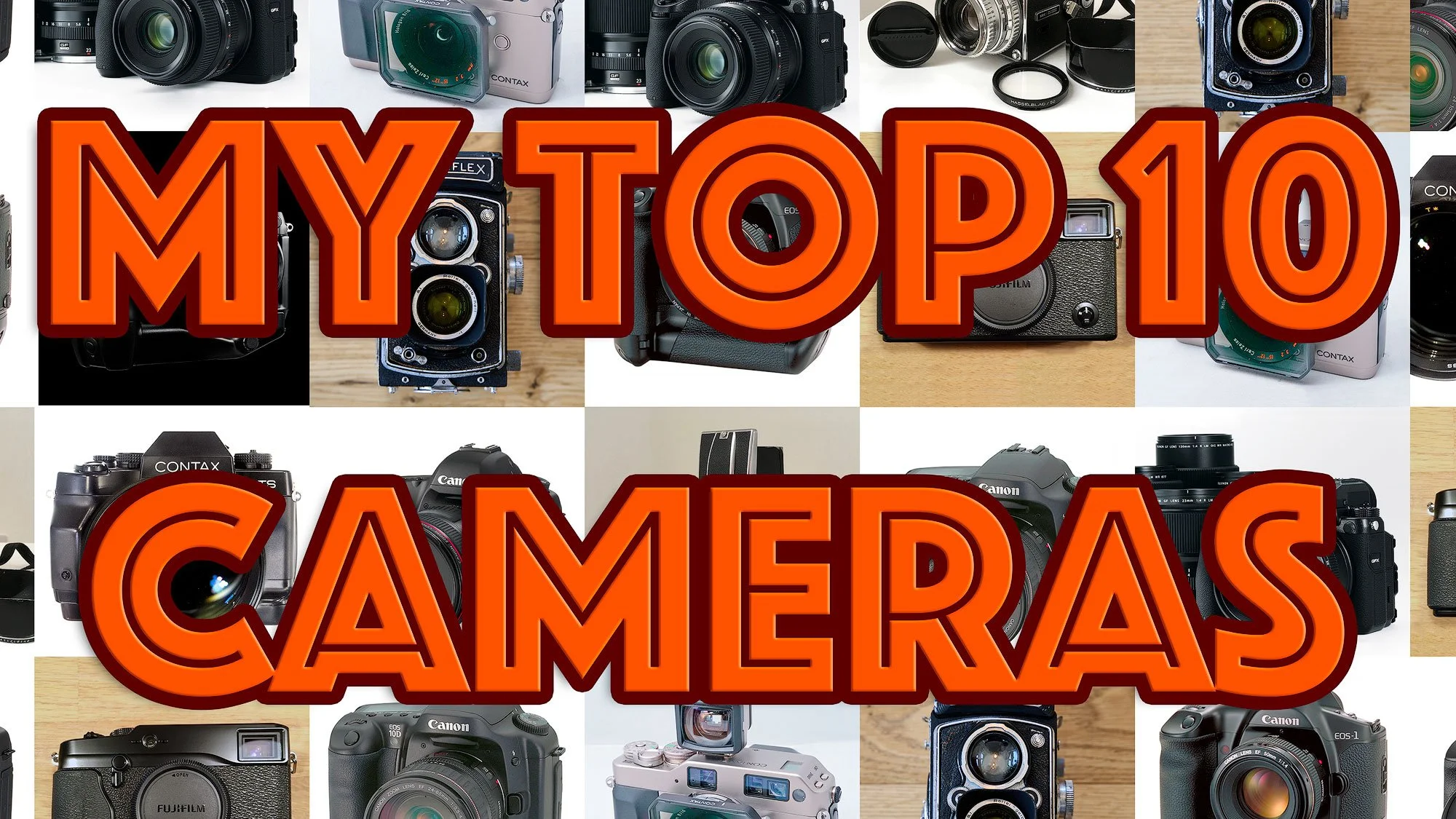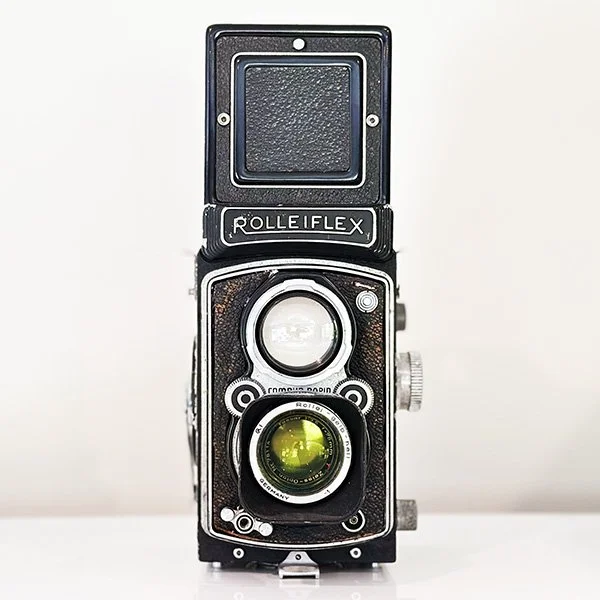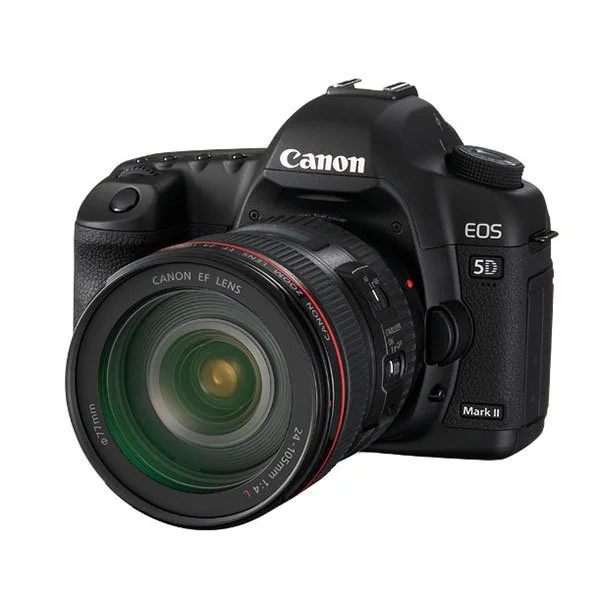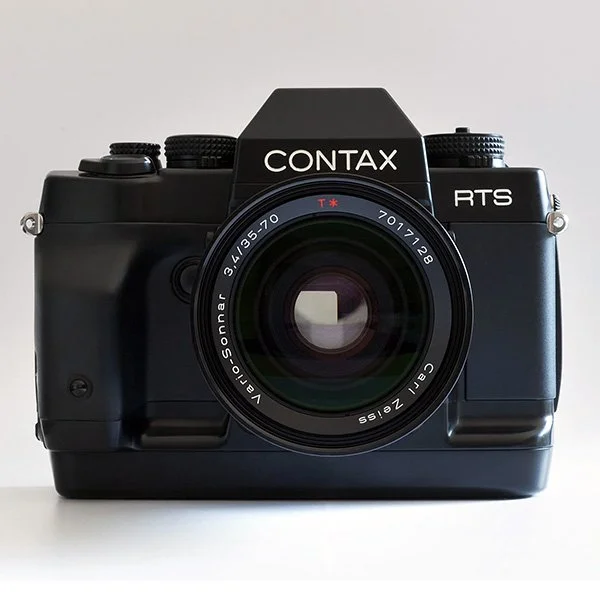MY TOP 10 CAMERAS
2nd September 2025
Some obvious ones,
some less so.
The main criteria is that I have actually owned and used all of these cameras, as opposed to just read about them.
Therefore, I feel well placed to comment on what ticks the boxes for me and what defines a true classic.
You will notice only half of my top 10 cameras list are digital, but for me these are the ones that broke new ground or are simply inspirational to use.
After all, digital cameras are merely boxes full of electronic components, mostly devoid of any real character and certainly no match for the best film cameras that are fabulously tactile masterpieces of mechanical engineering.
10. CANON EOS 10D
Maybe an unlikely inclusion in my top 10 cameras but this was the first affordable digital SLR that could actually be relied upon for professional use. Launched in 2003, the 10D had 6.3 megapixels and 7 autofocus points, saving the images to CompactFlash or the fragile IBM Microdrive media (£499 for 1GB!). I shot hundreds of motorsport events with this camera, in all kinds of weather and it never let me down. Used with the original EF 70-200 f/2.8 lens, the 10D AI Servo autofocus was plenty good enough to track moving cars, I always selected just one focus point to make sure the camera focused where I wanted it to. Paired with the EF 24-70 f/2.8 lens and the Speedlite 580EX, the 10D did a great job for presentations, portraits and general media/PR work.
Image – Canon
9. ROLLEIFLEX AUTOMAT
Now 75 years old, my Rolleiflex K4/50 still produces stunning images and provides a thoroughly enjoyable, immersive shooting experience. It will never be a museum piece but the ‘patina’ means I don’t have to worry too much when taking it out, consequently it is the film camera I use the most today. A roll of Kodak Ektar 100 will produce some wonderfully colourful, bright images but this camera it is equally at home with black and white film such as Ilford’s FP4+. 120 roll film is used giving 12off 56mm square photographs per film, this is ‘proper’ medium format with an image area around 3 times larger than 35mm film (36mm x 24mm) or a full-frame digital camera, therefore massive crops to virtually any shape or size are possible.
8. CONTAX G1
Often dismissed as male jewellery when introduced in 1994, this titanium clad autofocus rangefinder style gem is in fact the forerunner of the modern interchangeable lens mirrorless camera. The styling hints at the classic CONTAX IIa and IIIa rangefinders from the late 1940s and early 50s but even today the G1 looks modern and it clearly inspired the design of the famed Hasselblad X-Pan and the FujiFilm TX-1. Although berated these days by ‘armchair experts’, the G1’s somewhat basic passive autofocus system (in effect a ‘digital rangefinder’) is adequate for a camera of this type and it must be realised that your subject needs to have a decent amount of contrast for it to work correctly. The autofocus can occasionally be slightly off with the Sonnar T* 90mm f/2.8 lens, but of course this lens has much less depth of field than the other CONTAX G lenses, so a bit more effort is required with this lens. Speaking of lenses, the Planar T* 45mm f/2 is one of the finest 35mm format lenses ever produced and worth leaving on the G1 most of the time. The manual focus only, rare, expensive and exotic Hologon T* 16mm f/8 lens was always a challenge to use but great fun at the same time. The G1 was a camera that made you feel good, especially if wearing the luxury Goldpfeil leather bag on your shoulder that had special compartments for the camera and the 3 original lenses (28, 45 and 90 mm).
7. FUJIFILM X-PRO 1
The modern day CONTAX G1, fabulous to look at, tactile to hold and superb to use. A digital classic from 2012, the X Pro 1 makes the best images of any FujiFilm X series camera, especially with the Fujinon XF 35mm f/1.4 R lens. The original 16 megapixel X-Trans sensor has that magic film-like look, images are not over-sharpened, the highlights don’t blow out, there are smooth graduations between dark and light tones. It doesn’t feature blazingly fast autofocus, nor does it shoot at 15 frames per second, but as with the CONTAX G1 above, it will reward your efforts far more than most ‘whizz-bang’ current digital cameras. Probably deserving of a higher ranking in my top 10 cameras.
6. HASSELBLAD 500C
Firstly, there is the total joy of seeing your composition (upside down) on a fabulous piece of ground glass. That is before you have even wound the film on and felt the exquisite meshing of precision gears or experienced the aural assault on the senses that is the mirror going up and down, this is a true engineering marvel. Combined with some of the best Carl Zeiss glass, the images have an amazing 3D look to them that no digital camera has yet come close to replicating. My first 500C was from 1967 and came with the standard Planar T* 80mm f/2.8 lens bearing the inscription A&AEE. Clearly this camera had originally been owned by the Aeroplane and Armament Experimental Establishment at Boscombe Down in Wiltshire, quite possibly used for the air-to-air photography of test flights. Wish I had kept it as it cost just £199 not that long ago, any half-decent 500C now pushes £1000.
5. CANON 5D MARK II
One of only a handful of digital cameras that can rightly be referred to as a classic and fully justified of its place in the top half of my top 10 cameras list. The original 5D had terrible autofocus and the 12.8 megapixel sensor produced OK images but nothing to get excited about. All that changed in late 2008 with the launch of the Mark II version, 21.1 megapixels, a superb 3 inch rear LCD and a 9 point autofocus system that worked pretty well for most subjects. There was a natural ‘film-like’ look to the images that hasn’t been bettered by any of the subsequent 5D models, which, to my eyes anyway, look flat and lifeless. Although of no interest personally, the 5D Mark II was also the first full-frame DSLR to offer 1080p video recording. Many are still in daily use for this purpose and one of the reasons why decent used cameras still command good prices. If you can find a low mileage example with the original box and accessories then grab it, probably the best few hundred quid you will ever spend on a camera, the EF 24-105mm f/4L IS USM lens is a perfect match.
Image – Canon
4. SONY ALPHA A7 III
In many ways the mirrorless equivalent of the Canon EOS 5D Mark II. It doesn’t have the headline grabbing features of other Sony mirrorless cameras such as high-megapixel count, crazy frames-per-second bursts or ‘track anything’ autofocus, but as an overall package it just works. As a night sky/astro photography tool, the low noise threshold and the brilliant ‘see in the dark’ Bright Monitoring feature make the A7 III just about as good as it gets. Pair it with the superb Sony 20mm f/1.8 G lens for the best Milky Way and Aurora Borealis (Northern Lights) combo money can buy. The A7 III is also a powerful video camera and immensely popular on the used market, one of the few digital cameras where secondhand prices have actually risen in the last year. In fact, I sold my last A7 III back to a dealer for a profit!
Image - Sony
3. FUJIFILM GFX100S
My GFX journey began at the Photography Show in 2017 when I first saw the original GFX50S camera. It seemed to be the perfect landscape photography camera, but at a price. Still good value for a ‘medium format’ digital camera though, compared to what had gone before. I have owned both the GFX50S and the GFX50R cameras, no doubting the superb image quality, but I found both cameras frustrating to use for various reasons. In 2021 the GFX100S was launched with a 102 megapixel sensor, the camera body being a similar size and weight to a DSLR, a decent enough autofocus system and reasonable in-body image stabilisation (IBIS). I waited until the used prices had dropped below £3000 and bought one. Totally underwhelmed would be an understatement, the images were kind of lacking the amazing 3D ‘I was there’ of the original 50 megapixel GFX cameras. I tried several GF lenses before bailing out and returning to Sony cameras for a couple of years. Come 2025 and the GFX bug was still gnawing away inside, the launches of the GFX100 II and the GFX 100S II made the GFX100S a decent buy on the used market, so I grabbed one. Instantly my images just leapt out from the computer screen, maybe a little bit more ‘clinical’ than the original ‘filmic’ 50S/50R, but superb all the same. I read somewhere “once you see the GFX image quality, you can't ‘unsee’ it and it will haunt you if you don't have it after you have seen it.” Used correctly (and it took some practice), the GFX100S will make landscape images of a quality that are simply not possible with any full-frame camera. It’s not an action camera and the range of lenses is still small, not to mention plain Fujifilm weird, with overlaps in focal lengths etc. On the used market, the GF lenses are no more expensive, cheaper in many cases, than full-frame lenses from Canon, Sony or Nikon. Compared to Hasselblad X system lenses they are a total bargain.
Nearly all of my Latest Images on this website were made with the GFX100S.
My friend Francesco Gola has written a couple of excellent articles about the GFX100S - here and here.
Image - Fujifilm
2. CANON EOS 1N HS
Quite simply the only camera(s) I’ve ever owned or used that did EVERYTHING I wanted it to and it came very close to taking the top spot. HS for ‘High Speed’, with the PB-E1 booster it could fire up to 6 frames per second, a roll of film could be despatched in 6 seconds flat, super-fast for 1994. Although lacking traditional control dials this was a camera with everything laid out logically and it quickly became second nature to use. I had a pair of these, one permanently attached to a EF 28-70 f/2.8 and the other sported either an EF 80-200 f/2.8 or the marvellous EF 300mm f/2.8 I borrowed from Magnum photographer Ian Berry, probably the sharpest piece of glass I have ever used. This lens had been heavily breathed on by the top techs at Canon Professional Services and had a matched pair of 1.4x and 2x Extenders that had also been modified, allowing them to be stacked. Both of my EOS 1N HS’ were part-exchanged, along with some other gear, in early 2001 for the new EOS D30 digital SLR camera, 3.1 megapixels and £1895!
Image – Canon
1. CONTAX RTS III
So here it is, the Numero Uno in the list of my top 10 cameras!
I went back and forth between this and the EOS 1N HS many times, but in the end my emotional attachment to the CONTAX RTS III won the day. I was the Service & Technical Manager for Kyocera (KYOto CERAmic company) Yashica UK in the 1990s, not only servicing and repairing these cameras but also providing on-site technical backup for professional users as well as product training for the CONTAX Specialist dealers. As with the previous ‘Real Time System’ cameras there were a number of firsts when the RTS III was unveiled in 1990 – the most notable being the Real Time Vacuum Back that sucked the film flat onto the ceramic pressure plate in order to achieve the full potential of the Carl Zeiss lenses. There was also a Pre-Flash lever that would fire the flash or studio lights and the reflected light would hit a small sub-mirror, mounted under the main reflex mirror, enabling precise TTL flash metering in auto and manual modes without having to shoot Polaroid test shots. This camera had it all; magnesium top cover, titanium bottom cover, 5 frames per second integrated motor drive, multiple exposures, 2 or 10 second self-timer, exposure compensation, auto bracketing, 1/8000th second maximum shutter speed, titanium shutter, centre weighted or 3mm spot metering, mirror-up lever, diopter adjustment, eyepiece blind, built-in databack (time and date between frames NOT over the image), film rewind that left the leader out meaning film could be changed mid-roll. The top cover featured clearly marked dials and levers for all of the main camera functions, you can see where FujiFilm took their cues from when designing the XT series and the GFX 50S. An expensive (£1895 in the 90s!), huge and heavy camera, 1.15kg with the 6 AA batteries, the RTS III exuded quality and class from every perspective. I used this camera mostly with the Carl Zeiss Distagon T* 35mm f/1.4, Planar T* 50mm f/1.4 and Planar T* 85mm f/1.4 lenses and very occasionally with the company demo Tele-Apotessar T* 300mm f/2.8 that cost the same as a luxury car back then! In my opinion the best camera ever made and one that takes pride of place in my ‘camera museum’.
Image – thanks to Tom Sebastiano, check out his excellent CONTAX RTS III review here
“There are many other cameras that could have made the Top 10, including the Contax 645, Fuji GX617, Hasselbad XPan, Leica M3 or M6, Canon EOS 1DX Mark III, R1 + R3 etc. but I have neither owned any of these cameras (yet!), nor have I used them for long enough to form a proper opinion.”
IF ANY OF MY TOP 10 CAMERAS HAVE PIQUED OR REKINDLED AN INTEREST FOR YOU, I WOULD SUGGEST LOOKING NO FURTHER THAN MY LIST OF RECOMMENDED ‘GEAR SPECIALISTS’ BELOW. ALL HAVE KNOWLEDGEABLE STAFF AND GREAT PRICES, THE ITEMS HAVE BEEN FULLY TESTED WITH AN APPROVAL PERIOD (NORMALLY 10 TO 14 DAYS FROM RECEIPT) AS WELL AS (IN MOST CASES) A 3 OR 6 MONTH GUARANTEE.
FAR BETTER THAN A FACELESS EBAY PURCHASE THAT IS OFTEN MORE EXPENSIVE AND A SCRUFFY, OR SOMETIMES EVEN FAULTY, ITEM.
AVOID ‘MINT OR NEAR MINT FROM JAPAN’ AT ALL COSTS, THEY SELDOM ARE!










